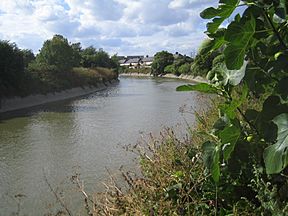Prescott Channel facts for kids
Quick facts for kids Prescott Channel |
|
|---|---|

The Prescott Channel in July 2006, with cultivated fig tree
|
|
| Specifications | |
| Locks | 1 |
| Status | Open |
| Navigation authority | Canal & River Trust |
| History | |
| Date of act | 1930 |
| Date closed | 1960s |
| Date restored | 2009 |
| Geography | |
| Connects to | Bow Back Rivers |
The Prescott Channel is a special waterway in the East End of London, England. It was built between 1930 and 1935. Its main job was to help control floods on the River Lee Navigation. The channel was named after Sir William Prescott, who was in charge of the Lee Conservancy Board at the time. Later, in 1962, parts of the old Euston Arch were used to make the channel even better. The Prescott Channel is also part of a bigger group of waterways called the Bow Back Rivers.
Contents
The Prescott Channel's Story
Building Three Mills Lock
The Three Mills Lock was built in the Prescott Channel. A lock is like a water elevator that helps boats move between different water levels. This lock was built to help carry building materials for the London 2012 Olympics. It also helped stop the natural flow of the tide (called canalisation) in the channel and the River Lee to the north.
Construction of the lock started in March 2007 and finished in June 2009. This project brought many good things. It helped barges carry construction materials and recycled items between Stratford and the River Thames. It also created new chances for fun boats, water taxis, and even floating restaurants!
The lock is 62 metres (about 203 feet) long, 8 metres (about 26 feet) wide, and 2.4 metres (about 8 feet) deep. It is big enough to hold two barges, each weighing 350 tonnes. Other locks on the Lower Lee River could only hold barges of about 120 tonnes. The lock was designed by Tony Gee and Partners and built by Volker Stevin.
An Unexpected Discovery
On June 2, 2008, workers digging in the channel found something surprising. They discovered a 2,200-pound (1,000 kg) Hermann bomb from the Second World War. This bomb was very old and had been hidden for 67 years.
Because of the bomb, people living nearby had to leave their homes. Train services were stopped, and flights from London City Airport were changed. After five days, experts from the Army Bomb disposal unit safely exploded the bomb. The explosion threw 400 tonnes of sand into the air! An army expert said that if the bomb had exploded during the war, it could have caused a lot of damage to buildings and sewers. He also said it was the biggest unexploded bomb ever found in central London.
Finding Pieces of History
In 2009, as part of the lock project, workers found 29 large stones at the bottom of the river. These stones were from the Euston Arch, a famous old building that was taken down in 1962. The stones were given to the Euston Arch Trust, a group that wants to rebuild parts of the arch. One stone had already been found in 1994 by Dan Cruickshank for a BBC Television show called 'One Foot in the Past'.


